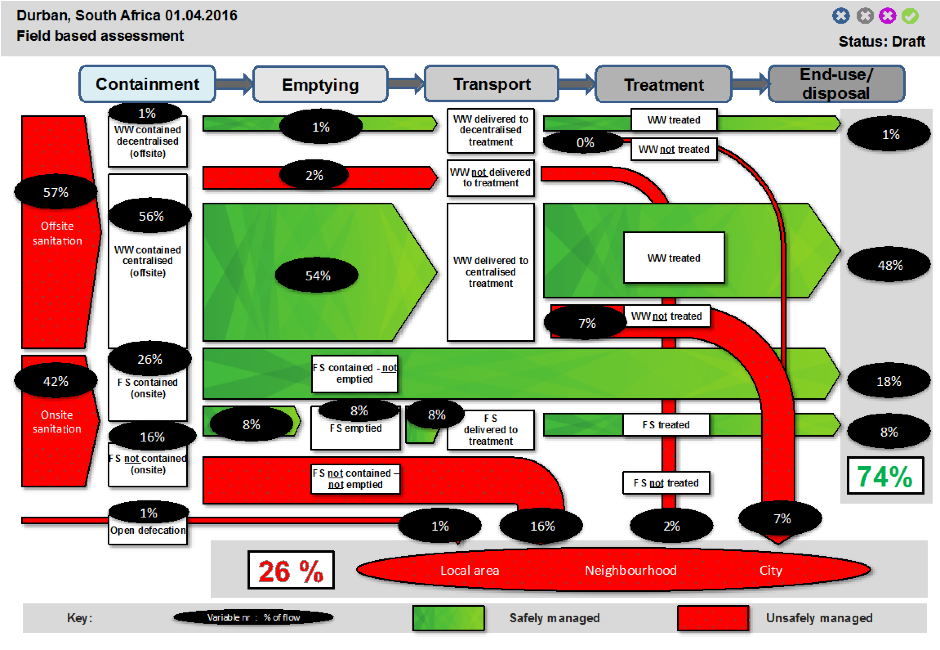Development of a Shit Flow Diagram (SFD) for Durban
February to May 2016
Project description
The object of this study was to develop a Shit Flow Diagram (SFD) for the city of Durban and the surrounding eThekwini area. A SFD is the graphic representation showing the pathways of the faeces produced by the contributing population. They are meant as a communication tool that would support decision-making around the faecal sludge system. The pathway of faeces from creation to disposal helps to identify risks and weaknesses along the sanitation chain. The SFD and Service Delivery Analysis report were created through field-based research undertaken at the Pollution Research Group (PRG) in the University of KwaZulu-Natal (UKZN) as an internship project for the final requirements of the Integrated Water Resource Management Masters program at McGill University. The collaborating partners in this study were the eThekwini Water and Sanitation Municipality (EWS) and Sandec.
The SFD that was developed can be seen in Figure 1. Durban was found to have a strong legislation and framework for the development and operation of good sanitation systems. The city is primed for service delivery. The study showed that 74% of excreta is managed safely, with 48% coming from waterborne toilets on the central sewer network. The bulk of the excreta that is not safely managed is from the unserved households (making up 16% informal pits that are not emptied or buried and 1% open defecation where toilets are broken or by children) as well as the estimated untreated flow from wastewater treatment works.

Figure 1: SFD for Durban, South Africa, 2016
The sanitation systems that exist in eThekwini for the 3.5 million people were found to be 57% off-site sanitation and 42% on-site sanitation. The off-site sanitation is flush waterborne toilets to sewer networks going to centralised (56% of the population) or decentralised treatment facilities (1% of population). Included in these off-site sanitation systems are the ablution blocks that are set up for informal settlements that are awaiting housing developments. Faecal matter is released to the environment unsafely via the sewer network from blockages in the gravity and pump driven system. While it has been calculated that only 2% of the population have their waste lost this way, this figure needs to be confirmed due to its low level of accuracy from the interviews.
The on-site sanitation is either: urinary diversion (UD) toilets that have the faecal sludge buried onsite or taken to the black soldier fly treatment facility; ventilated improved pit latrines (VIP) that have the excreta sludge emptied and taken to the LaDePa treatment facility; and septic or conservancy tanks that have a soak away, with the solid sludge emptied and delivered to the centralised treatment facility. All sludge that is contained onsite and then taken to the treatment facility makes up 8% of the population. The backlog figure for people that are not served by the municipality with basic sanitation facilities make up 17% of the population. Out of this a small amount of the rural dwellings were assumed to practice open defecation, making up 1% of the population. The rest of the rural and the urban dwellings that are unserved by the municipality are assumed to use improperly maintained and constructed pits latrines that are not emptied, which is considered to be unsafe release of faecal contamination to the environment.
The SFD study was developed with the active engagement of EWS, with hopes to integrate the development of a SFD into their regular reporting procedures. This engagement was done through one-on-one interviews with key divisions within EWS.
Relevant Publications and Reports
Journal Publications
Posters
Conference Papers and Presentations
Reports and Other